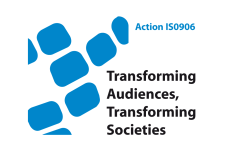- About the Action
- Events
- PhD workshop - Ljubljana 2014
- Action Open Conference - Ljubljana 2014
- New Media and Participation conference - Istanbul 2013
- Belgrade meeting 2013
- Media literacy research and policy - Brussels 2013
- ICA Pre-Conference 2013
- Tampere meeting 2013
- Budapest workshop 2012
- Milan meeting 2012
- Brussels PhD workshop 2012
- Brussels Action workshop 2012
- London meeting 2011
- Zagreb Conference 2011
- Lisbon meeting 2010
- Affiliated events
- WG 1
- WG 2
- WG 3
- WG 4
- Cross-WG
- Output
Methodological Approaches to Study of Interactivity in Communication Journals
Milojevic, A., Kleut, Jelena, Ninkovic, Danka (2013). Methodological Approaches to Study of Interactivity in Communication Journals. COMUNICAR, XXI(41), 93-102.
http://www.revistacomunicar.com/index.php?contenido=detalles&numero=41&articulo=...Abstract: The aim of this paper is to map out the research around the concept of interactivity, as well as to point out the dominant streams and under researched areas. It is based upon the content analysis of methods employed in articles published in five top ranking communication journals over five year period (200610). The review of methods applied in research of interactivity is based upon distinction between social interactivity, textual interactivity and technical interactivity. This classification is further developed by adding the category of levels of interactivity (low, medium and high) which allows further classification of different mediated practices. This leads to specification of nine theoretical subsets of interactivity as the main categories of the analysis of research articles. Within this matrix we have situated diverse methods that respond to conceptually different types and levels of audience/users interactivity. The analysis shows that scholarly focus lies within the low textual and the high social interactive practices, whereas the high technical and high textual interactivity are under researched areas. Investigations into the audience/users relations with texts are mainly orientated towards content analyses and surveys. High social interaction research is reviving the application of ethnographic methods, while the possibilities of technical interactivity are embraced not as an object but as a tool for research.

